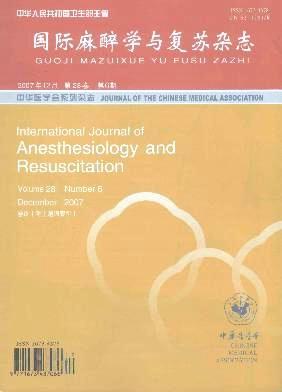The minimum local anesthetic concentration of ropivacalne for ultrasound-guided phrenic nerve block in the treatments of central hiccup
引用次数: 0
Abstract
Objective To determine the minimum local anesthetic concentration of ropivacalne for ultrasound-guided phrenic nerve block in the treatments of central hiccup. Methods In this experiment, sequential experimental method was used to select patients with hiccup after the operation of cerebral hemorrhage. The starting concentration of ropivacaine was 0.25%. The ratio between adjacent concentrations was 1.3. The superficial phrenic nerve on the left anterior scalene muscle of all patients were located by ultrasound. The predetermined concentration of ropiacaine 4 ml was injected. After twenty minutes, whether the injection works or not was judged by observing the symptom of all patients. If the first one is effective, the next injection dose will be decreased one concentration gradient. If the block was not effective, then 4 ml of 1.5% lidocaine will be injected at the same lateral phrenic nerve. If the block is still not effective, the next injection will be ropivacaine with increased one concentration gradient. If the hiccups still did not end, the routine drug treatment will be used. At the same time, with the approval of the patients′ family, after eight hours, we will take the right phrenic nerve block. Then this case will not be included in the data statistic. The next patient continues to use the same initial concentration ropivacaine. The effective cases were included in effective group(group A) while the cases with lidocaine supplement were divided into invalid group (group B). The drug concentration, blocking effect, median effective dose(ED50) and 95% confidence intervals (CI) were calculated according to Dixon and Brownlee methods. Results Ultrasound-guided application of ropivacaine for phrenic nerve block for central hiccup is safe, effective and requires little medication. 95%CI of ultrasound-guided phrenic nerve block for central hiccup is 0.267%-0.335%. Conclusions The minimum effective concentration of ropivacaine in the treatment of central hiccup was 0.299%. Key words: Phrenic nerve; Nerve blocking anesthesia; Hiccup; Ultrasound-guided; Ropivacaine超声引导膈神经阻滞治疗中枢性呃逆时罗哌卡因最小局麻浓度
目的确定超声引导膈神经阻滞治疗中枢性呃逆的罗哌卡因最小局麻浓度。方法采用序贯实验法对脑出血术后呃逆患者进行筛选。罗哌卡因的起始浓度为0.25%,相邻浓度之比为1.3。超声定位所有患者左前斜角肌膈浅神经。注射预定浓度的4毫升罗哌卡因。20分钟后,通过观察所有患者的症状来判断注射是否有效。如果第一次注射有效,下一次注射剂量将减少一个浓度梯度。如果阻滞无效,则在同一侧膈神经处注射4ml 1.5%利多卡因。如果阻断仍然无效,下一次注射将是增加一个浓度梯度的罗哌卡因。如果打嗝仍未结束,将采用常规药物治疗。同时,在患者家属的同意下,8小时后,我们将进行右侧膈神经阻滞。那么这种情况将不会包含在数据统计中。下一位患者继续使用相同初始浓度的罗哌卡因。有效病例分为有效组(A组),补充利多卡因病例分为无效组(B组)。根据Dixon和Brownlee方法计算药物浓度、阻断效果、中位有效剂量(ED50)和95%置信区间(CI)。结果超声引导下应用罗哌卡因膈神经阻滞治疗中枢性呃逆安全有效,用药少。膈神经阻滞治疗中枢性呃逆的95%可信区间为0.267%-0.335%。结论罗哌卡因治疗中枢性打嗝的最低有效浓度为0.299%。关键词:膈神经;神经阻滞麻醉;打嗝;超声引导;罗哌卡因
本文章由计算机程序翻译,如有差异,请以英文原文为准。
求助全文
约1分钟内获得全文
求助全文

 求助内容:
求助内容: 应助结果提醒方式:
应助结果提醒方式:


